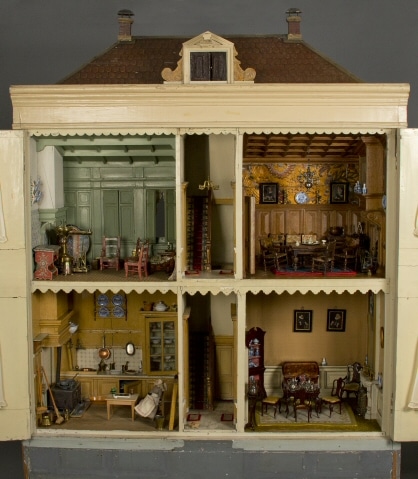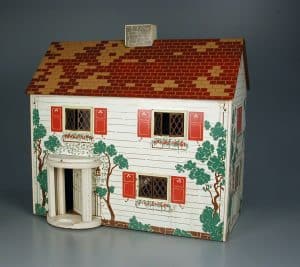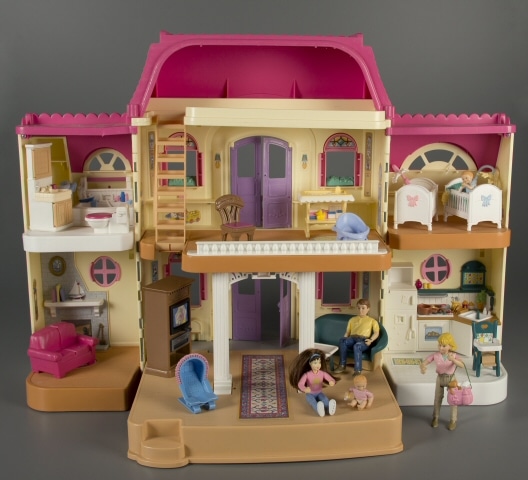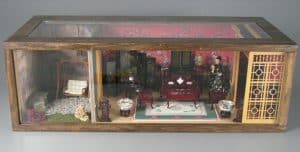In case you missed the media blitz, on November 10, the National Toy Hall of Fame at The Strong announced its 2011 inductees: the dollhouse, Hot Wheels, and the blanket. If you read my early November blog, you know that I thought the puppet, one of the 12 finalists for this year’s induction, was a shoo-in—just goes to show you that even insiders cannot always guess well!
I concede that each of this year’s inductees certainly belongs in the Toy Hall of Fame, but I have a special fondness for the dollhouse, probably because I remember the metal Louis Marx dollhouse and its furnishings from the 1950s which my sisters and I played with long (long, long) ago. The dollhouse’s place in play, however, started well before then.
 Historians trace the origins of the dollhouse to 16th-century elaborate cabinets in which wealthy European women displayed their collections of miniatures. Called baby houses, these wooden structures contained several compartments, and each compartment represented a room furnished with tiny handcrafted household items and furniture. The cabinets were the exclusive playthings of adults and, in showcasing finely made furnishings of exotic woods, metals, fabrics, and other materials, the baby house demonstrated a woman’s wealth and good taste. The first record of a miniature house made for children dates to 1558, when Albrecht V, Duke of Bavaria, ordered a dollhouse for his daughter. The dollhouse so pleased the Duke (and presumably his daughter) that he listed it among the works of art he owned in an inventory of his household.
Historians trace the origins of the dollhouse to 16th-century elaborate cabinets in which wealthy European women displayed their collections of miniatures. Called baby houses, these wooden structures contained several compartments, and each compartment represented a room furnished with tiny handcrafted household items and furniture. The cabinets were the exclusive playthings of adults and, in showcasing finely made furnishings of exotic woods, metals, fabrics, and other materials, the baby house demonstrated a woman’s wealth and good taste. The first record of a miniature house made for children dates to 1558, when Albrecht V, Duke of Bavaria, ordered a dollhouse for his daughter. The dollhouse so pleased the Duke (and presumably his daughter) that he listed it among the works of art he owned in an inventory of his household.
 The idea of a dollhouse for children caught on soon after. In Europe, especially Germany, toy makers in the 17th and 18th centuries produced miniature houses for youngsters. These tiny models of homes and their furnishings introduced children to household management and decoration. In the 19th century, mass-production methods allowed toy manufacturers to offer dollhouses cheaply, and more children of the growing middle class played with these miniature houses in their nurseries. By the turn of the 20th century, well-known manufacturers such as Christian Hacker and Moritz Gottschalk of Germany, Siber & Fleming and the Lines Brothers of England, and R. Bliss, A. Schoenhut, and Converse in the United States supplied dollhouses and furnishings to suit everyone’s pocketbook. At the middle of the 20th century, many
The idea of a dollhouse for children caught on soon after. In Europe, especially Germany, toy makers in the 17th and 18th centuries produced miniature houses for youngsters. These tiny models of homes and their furnishings introduced children to household management and decoration. In the 19th century, mass-production methods allowed toy manufacturers to offer dollhouses cheaply, and more children of the growing middle class played with these miniature houses in their nurseries. By the turn of the 20th century, well-known manufacturers such as Christian Hacker and Moritz Gottschalk of Germany, Siber & Fleming and the Lines Brothers of England, and R. Bliss, A. Schoenhut, and Converse in the United States supplied dollhouses and furnishings to suit everyone’s pocketbook. At the middle of the 20th century, many  American toy companies offered dollhouses made of wood, cardboard, metals, and plastic. Companies such as Tootsietoy, Rich Toy Company, Keystone Manufacturing, Renewal, Louis Marx, and Plasco offered dollhouses and furnishings to satisfy every taste in architecture and style of furniture and décor. To this day, dollhouses made by Fisher-Price, Disney, Calico Critters, Hasbro, Kidkraft, Mattel, and others inspire hours of children’s play.
American toy companies offered dollhouses made of wood, cardboard, metals, and plastic. Companies such as Tootsietoy, Rich Toy Company, Keystone Manufacturing, Renewal, Louis Marx, and Plasco offered dollhouses and furnishings to satisfy every taste in architecture and style of furniture and décor. To this day, dollhouses made by Fisher-Price, Disney, Calico Critters, Hasbro, Kidkraft, Mattel, and others inspire hours of children’s play.
 Dollhouses, though, still intrigue adults. Many grown-up hobbyists make their own dollhouses and take great pleasure in re-creating miniature versions of home settings from their childhood, places they have traveled, or fantastic scenes of their imaginations. The tens of thousands miniature enthusiasts in America support a huge industry of steady sales and annual national and regional shows, conventions, and exhibits.
Dollhouses, though, still intrigue adults. Many grown-up hobbyists make their own dollhouses and take great pleasure in re-creating miniature versions of home settings from their childhood, places they have traveled, or fantastic scenes of their imaginations. The tens of thousands miniature enthusiasts in America support a huge industry of steady sales and annual national and regional shows, conventions, and exhibits.
So, okay. The dollhouse certainly belongs in the National Toy Hall of Fame. Perhaps the Hall of Fame will induct puppets next year.



